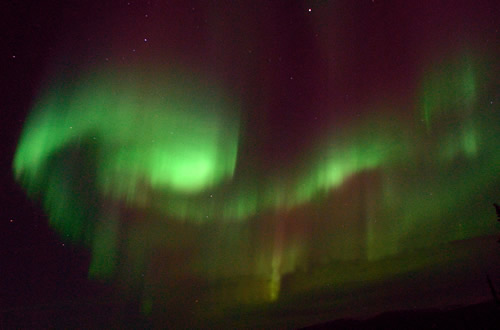About the Aurora
What causes the aurora? The aurora is a naturally occurring phenomenon of dancing light common to the night skies in high latitudes. It is formed year-round by the interaction between the Earth’s magnetic field and the constant stream of plasma (charged particles, also called the solar wind) emanating from our sun. Our magnetic field encircles the globe more or less concentrically (the pressure of the solar wind warps it on both sides), except at the poles, where it converges in near-parallel field lines. When the stream of plasma (ions) interacts with the magnetic field, charged particles move down those parallel field lines (according to Faraday’s Law) and transfer energy to the various gas molecules (nitrogen, oxygen, etc,) found in the upper atmosphere, which then release that energy in the form of light. (Very similar to what occurs in a fluorescent light bulb.) The different gases emit different colors at various energies. Green is the most common color emitted by the auroras, with red, yellow, blue and even violet occurring less frequently.
Neither the sun’s stream of ions nor the Earth’s magnetic field is constant. Both are ever changing due to various factors. Hence the auroras are generally not completely predictable as to their occurrence and intensity. Scientists monitor the activity of the sun and issue predictions for auroral activity based on the strength of the plasma stream. These predictions are probabilities, expressed as an index, with higher numbers meaning greater possible activity (through interaction with our magnetic field). An index of 2 or 3 is considered average, while one of 5 is generally recognized as a potential geomagnetic storm, capable of generating spectacular auroras. It must be stressed that, due to the shifting and vibration of the magnetic field lines, these indices are not hard fast determinants of aurora activity. It is possible to witness impressive displays on nights when the index is quite low (2); conversely, it sometimes happens that the auroras on a high probability night (4) are disappointing and do not light up the sky.
Where does one best view the auroras? Anywhere in the high latitudes (greater than 60 degrees North or South) of the world offers the best chances of seeing auroras in winter. The Fairbanks area is acknowledged as one of the world’s best places for viewing and photographing auroras because of its extreme northern location, generally clear winter skies, ease of access and more than adequate infrastructure. On an average night here in Alaska (with an index of 2-3 or less), the greatest possible chance of viewing auroras will occur broadly from the Alaska Range north into the Arctic. On nights of higher activity (index of 4-6), active auroras will be visible far to the south, down along the coast and into the Southeast Panhandle and even beyond.
The most intense aurora activity usually occurs late at night. This means you must be prepared to stay up way past your bedtime if you hope to see the best of this fabled light show! Most of the best aurora viewing will take place from 10 PM to 3 AM or later. Clear skies, naturally, are the best for seeing and photographing auroras, so it is necessary to pay attention to local weather conditions, which are ever changing here in Alaska. If you plan your stay in the Fairbanks area for three days or more during late fall through winter (October to April), your chances of seeing the aurora at least once are good to excellent.


